An Analysis of the Causes and Effects of Poverty in the U.S.
VerifiedAdded on 2020/05/28
|8
|1987
|150
Essay
AI Summary
This essay provides a comprehensive analysis of poverty in the United States, exploring its multifaceted causes and profound effects on individuals and society. The essay delves into various contributing factors, including overpopulation, illiteracy, casteism, gender inequality, financial imbalance, and natural disasters. It then examines the wide-ranging impacts of poverty, such as detrimental effects on child development, education, and family structures, as well as increased crime rates and malnutrition. The essay references statistical data, including the U.S. poverty rate, and highlights the vicious cycle of poverty, emphasizing the need for humanitarian efforts to address its complex challenges. The essay also provides a detailed overview of the impact on children and families, including health issues, educational setbacks, and family stress. The essay concludes by emphasizing the importance of understanding the causes and effects of poverty to develop effective solutions.
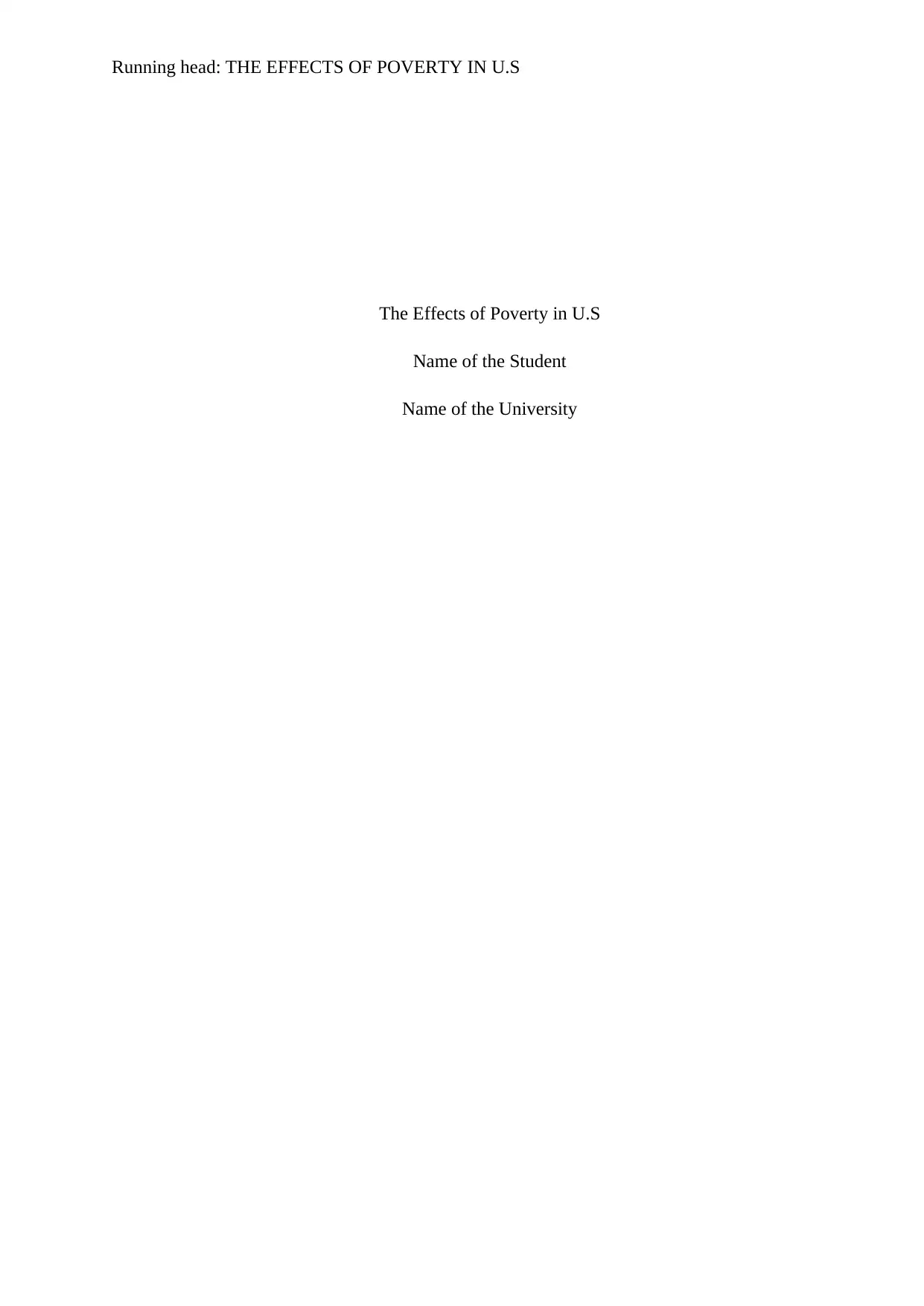
Running head: THE EFFECTS OF POVERTY IN U.S
The Effects of Poverty in U.S
Name of the Student
Name of the University
The Effects of Poverty in U.S
Name of the Student
Name of the University
Paraphrase This Document
Need a fresh take? Get an instant paraphrase of this document with our AI Paraphraser
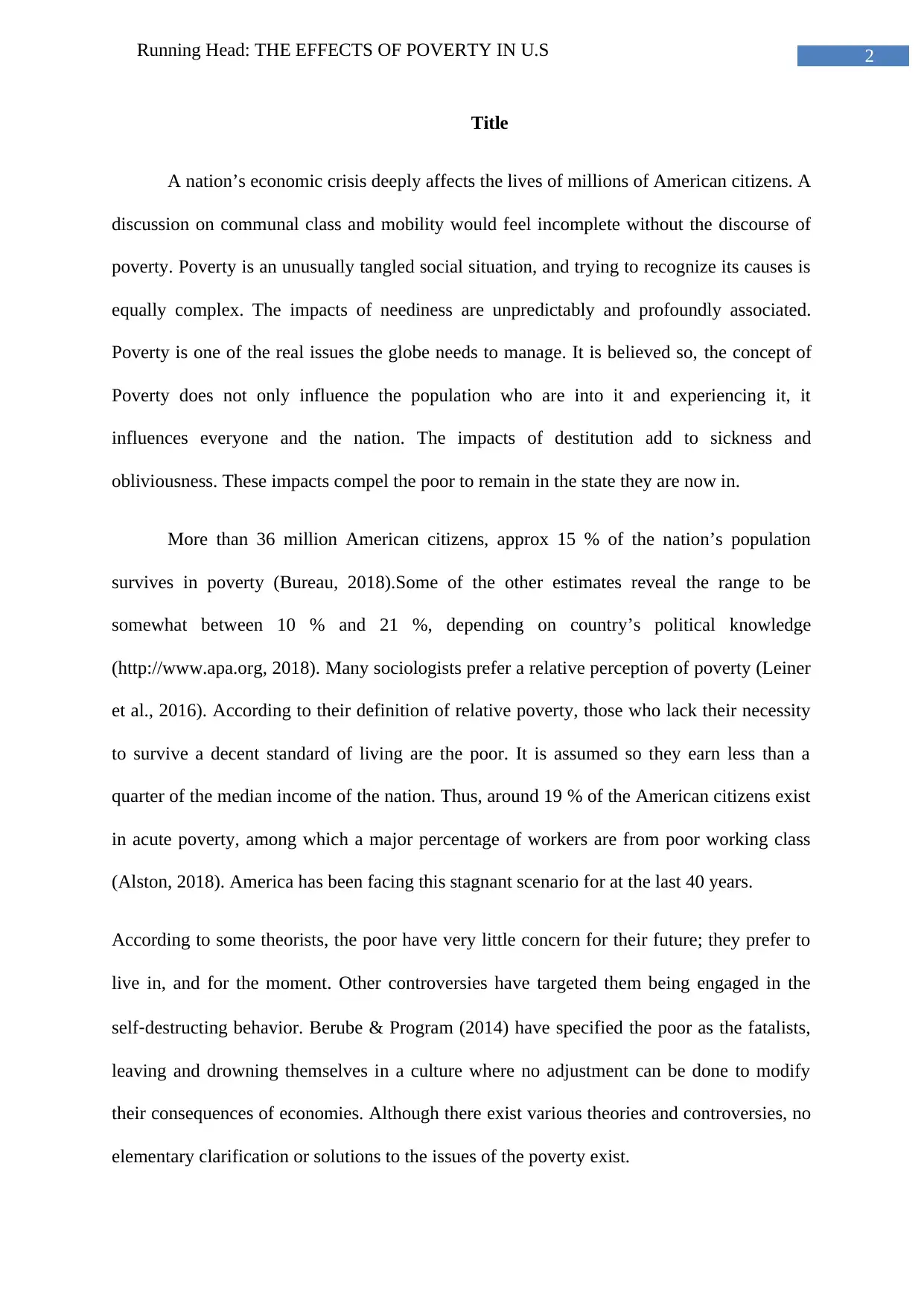
2Running Head: THE EFFECTS OF POVERTY IN U.S
Title
A nation’s economic crisis deeply affects the lives of millions of American citizens. A
discussion on communal class and mobility would feel incomplete without the discourse of
poverty. Poverty is an unusually tangled social situation, and trying to recognize its causes is
equally complex. The impacts of neediness are unpredictably and profoundly associated.
Poverty is one of the real issues the globe needs to manage. It is believed so, the concept of
Poverty does not only influence the population who are into it and experiencing it, it
influences everyone and the nation. The impacts of destitution add to sickness and
obliviousness. These impacts compel the poor to remain in the state they are now in.
More than 36 million American citizens, approx 15 % of the nation’s population
survives in poverty (Bureau, 2018).Some of the other estimates reveal the range to be
somewhat between 10 % and 21 %, depending on country’s political knowledge
(http://www.apa.org, 2018). Many sociologists prefer a relative perception of poverty (Leiner
et al., 2016). According to their definition of relative poverty, those who lack their necessity
to survive a decent standard of living are the poor. It is assumed so they earn less than a
quarter of the median income of the nation. Thus, around 19 % of the American citizens exist
in acute poverty, among which a major percentage of workers are from poor working class
(Alston, 2018). America has been facing this stagnant scenario for at the last 40 years.
According to some theorists, the poor have very little concern for their future; they prefer to
live in, and for the moment. Other controversies have targeted them being engaged in the
self‐destructing behavior. Berube & Program (2014) have specified the poor as the fatalists,
leaving and drowning themselves in a culture where no adjustment can be done to modify
their consequences of economies. Although there exist various theories and controversies, no
elementary clarification or solutions to the issues of the poverty exist.
Title
A nation’s economic crisis deeply affects the lives of millions of American citizens. A
discussion on communal class and mobility would feel incomplete without the discourse of
poverty. Poverty is an unusually tangled social situation, and trying to recognize its causes is
equally complex. The impacts of neediness are unpredictably and profoundly associated.
Poverty is one of the real issues the globe needs to manage. It is believed so, the concept of
Poverty does not only influence the population who are into it and experiencing it, it
influences everyone and the nation. The impacts of destitution add to sickness and
obliviousness. These impacts compel the poor to remain in the state they are now in.
More than 36 million American citizens, approx 15 % of the nation’s population
survives in poverty (Bureau, 2018).Some of the other estimates reveal the range to be
somewhat between 10 % and 21 %, depending on country’s political knowledge
(http://www.apa.org, 2018). Many sociologists prefer a relative perception of poverty (Leiner
et al., 2016). According to their definition of relative poverty, those who lack their necessity
to survive a decent standard of living are the poor. It is assumed so they earn less than a
quarter of the median income of the nation. Thus, around 19 % of the American citizens exist
in acute poverty, among which a major percentage of workers are from poor working class
(Alston, 2018). America has been facing this stagnant scenario for at the last 40 years.
According to some theorists, the poor have very little concern for their future; they prefer to
live in, and for the moment. Other controversies have targeted them being engaged in the
self‐destructing behavior. Berube & Program (2014) have specified the poor as the fatalists,
leaving and drowning themselves in a culture where no adjustment can be done to modify
their consequences of economies. Although there exist various theories and controversies, no
elementary clarification or solutions to the issues of the poverty exist.
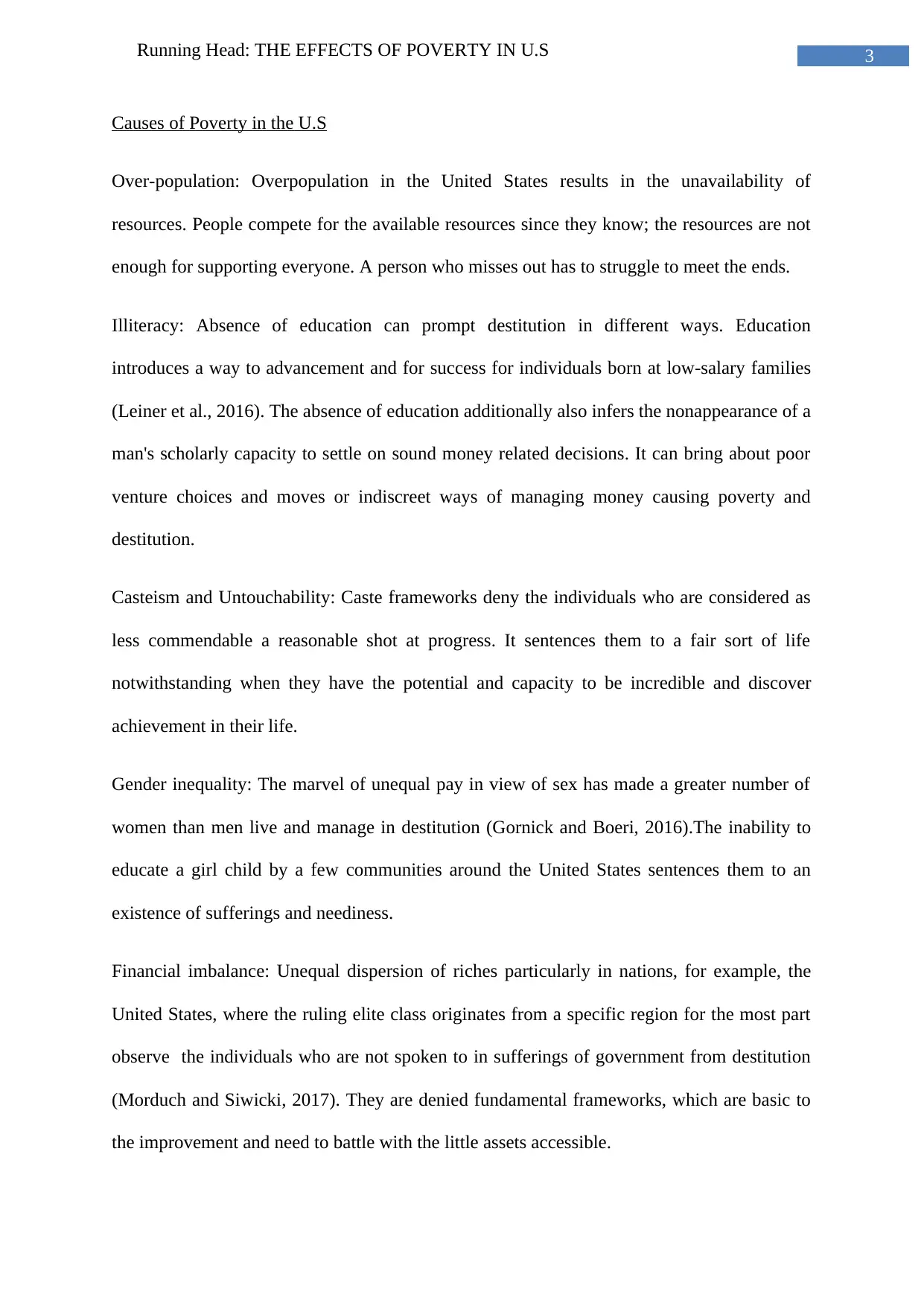
3Running Head: THE EFFECTS OF POVERTY IN U.S
Causes of Poverty in the U.S
Over-population: Overpopulation in the United States results in the unavailability of
resources. People compete for the available resources since they know; the resources are not
enough for supporting everyone. A person who misses out has to struggle to meet the ends.
Illiteracy: Absence of education can prompt destitution in different ways. Education
introduces a way to advancement and for success for individuals born at low-salary families
(Leiner et al., 2016). The absence of education additionally also infers the nonappearance of a
man's scholarly capacity to settle on sound money related decisions. It can bring about poor
venture choices and moves or indiscreet ways of managing money causing poverty and
destitution.
Casteism and Untouchability: Caste frameworks deny the individuals who are considered as
less commendable a reasonable shot at progress. It sentences them to a fair sort of life
notwithstanding when they have the potential and capacity to be incredible and discover
achievement in their life.
Gender inequality: The marvel of unequal pay in view of sex has made a greater number of
women than men live and manage in destitution (Gornick and Boeri, 2016).The inability to
educate a girl child by a few communities around the United States sentences them to an
existence of sufferings and neediness.
Financial imbalance: Unequal dispersion of riches particularly in nations, for example, the
United States, where the ruling elite class originates from a specific region for the most part
observe the individuals who are not spoken to in sufferings of government from destitution
(Morduch and Siwicki, 2017). They are denied fundamental frameworks, which are basic to
the improvement and need to battle with the little assets accessible.
Causes of Poverty in the U.S
Over-population: Overpopulation in the United States results in the unavailability of
resources. People compete for the available resources since they know; the resources are not
enough for supporting everyone. A person who misses out has to struggle to meet the ends.
Illiteracy: Absence of education can prompt destitution in different ways. Education
introduces a way to advancement and for success for individuals born at low-salary families
(Leiner et al., 2016). The absence of education additionally also infers the nonappearance of a
man's scholarly capacity to settle on sound money related decisions. It can bring about poor
venture choices and moves or indiscreet ways of managing money causing poverty and
destitution.
Casteism and Untouchability: Caste frameworks deny the individuals who are considered as
less commendable a reasonable shot at progress. It sentences them to a fair sort of life
notwithstanding when they have the potential and capacity to be incredible and discover
achievement in their life.
Gender inequality: The marvel of unequal pay in view of sex has made a greater number of
women than men live and manage in destitution (Gornick and Boeri, 2016).The inability to
educate a girl child by a few communities around the United States sentences them to an
existence of sufferings and neediness.
Financial imbalance: Unequal dispersion of riches particularly in nations, for example, the
United States, where the ruling elite class originates from a specific region for the most part
observe the individuals who are not spoken to in sufferings of government from destitution
(Morduch and Siwicki, 2017). They are denied fundamental frameworks, which are basic to
the improvement and need to battle with the little assets accessible.
⊘ This is a preview!⊘
Do you want full access?
Subscribe today to unlock all pages.

Trusted by 1+ million students worldwide
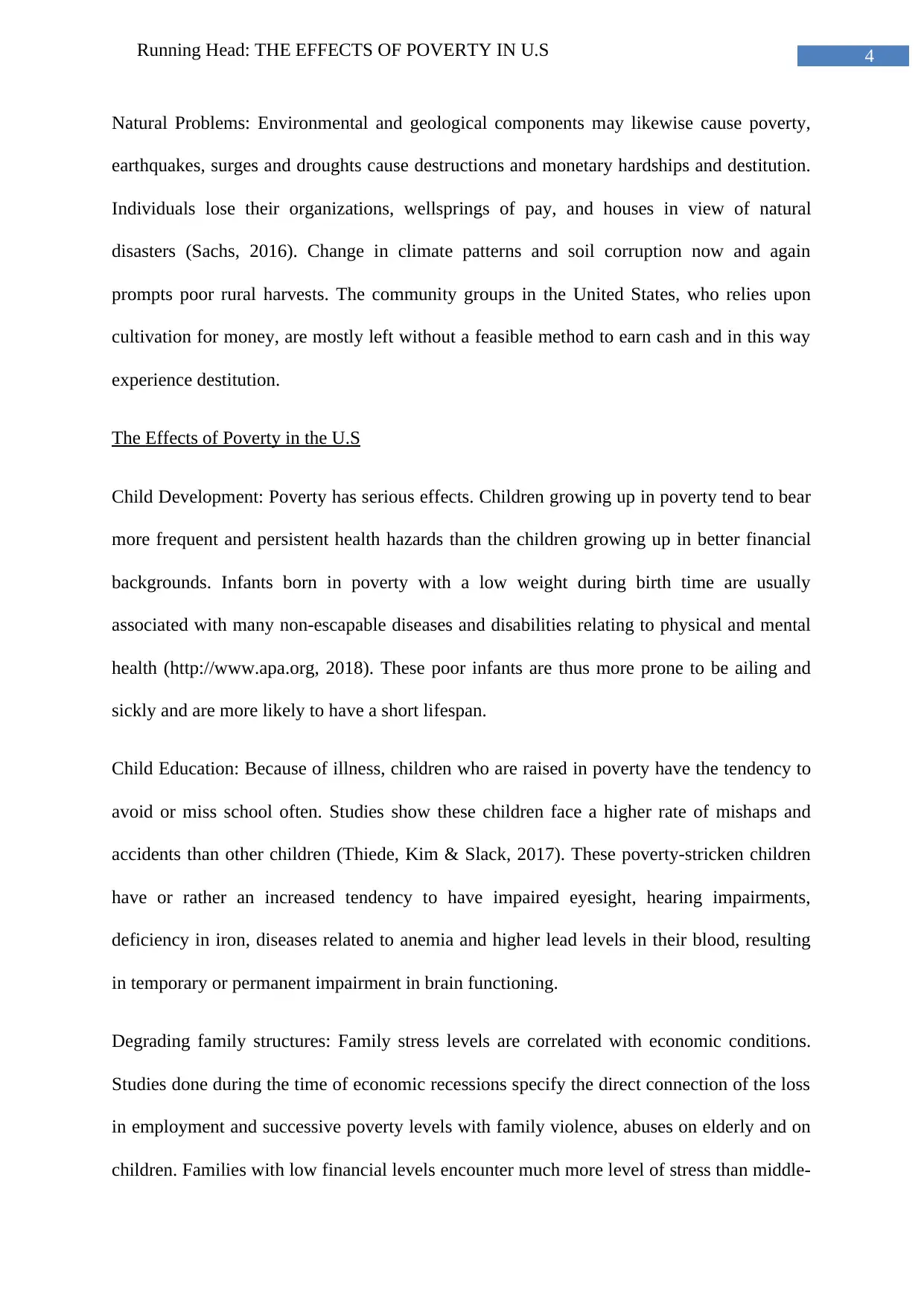
4Running Head: THE EFFECTS OF POVERTY IN U.S
Natural Problems: Environmental and geological components may likewise cause poverty,
earthquakes, surges and droughts cause destructions and monetary hardships and destitution.
Individuals lose their organizations, wellsprings of pay, and houses in view of natural
disasters (Sachs, 2016). Change in climate patterns and soil corruption now and again
prompts poor rural harvests. The community groups in the United States, who relies upon
cultivation for money, are mostly left without a feasible method to earn cash and in this way
experience destitution.
The Effects of Poverty in the U.S
Child Development: Poverty has serious effects. Children growing up in poverty tend to bear
more frequent and persistent health hazards than the children growing up in better financial
backgrounds. Infants born in poverty with a low weight during birth time are usually
associated with many non-escapable diseases and disabilities relating to physical and mental
health (http://www.apa.org, 2018). These poor infants are thus more prone to be ailing and
sickly and are more likely to have a short lifespan.
Child Education: Because of illness, children who are raised in poverty have the tendency to
avoid or miss school often. Studies show these children face a higher rate of mishaps and
accidents than other children (Thiede, Kim & Slack, 2017). These poverty-stricken children
have or rather an increased tendency to have impaired eyesight, hearing impairments,
deficiency in iron, diseases related to anemia and higher lead levels in their blood, resulting
in temporary or permanent impairment in brain functioning.
Degrading family structures: Family stress levels are correlated with economic conditions.
Studies done during the time of economic recessions specify the direct connection of the loss
in employment and successive poverty levels with family violence, abuses on elderly and on
children. Families with low financial levels encounter much more level of stress than middle-
Natural Problems: Environmental and geological components may likewise cause poverty,
earthquakes, surges and droughts cause destructions and monetary hardships and destitution.
Individuals lose their organizations, wellsprings of pay, and houses in view of natural
disasters (Sachs, 2016). Change in climate patterns and soil corruption now and again
prompts poor rural harvests. The community groups in the United States, who relies upon
cultivation for money, are mostly left without a feasible method to earn cash and in this way
experience destitution.
The Effects of Poverty in the U.S
Child Development: Poverty has serious effects. Children growing up in poverty tend to bear
more frequent and persistent health hazards than the children growing up in better financial
backgrounds. Infants born in poverty with a low weight during birth time are usually
associated with many non-escapable diseases and disabilities relating to physical and mental
health (http://www.apa.org, 2018). These poor infants are thus more prone to be ailing and
sickly and are more likely to have a short lifespan.
Child Education: Because of illness, children who are raised in poverty have the tendency to
avoid or miss school often. Studies show these children face a higher rate of mishaps and
accidents than other children (Thiede, Kim & Slack, 2017). These poverty-stricken children
have or rather an increased tendency to have impaired eyesight, hearing impairments,
deficiency in iron, diseases related to anemia and higher lead levels in their blood, resulting
in temporary or permanent impairment in brain functioning.
Degrading family structures: Family stress levels are correlated with economic conditions.
Studies done during the time of economic recessions specify the direct connection of the loss
in employment and successive poverty levels with family violence, abuses on elderly and on
children. Families with low financial levels encounter much more level of stress than middle-
Paraphrase This Document
Need a fresh take? Get an instant paraphrase of this document with our AI Paraphraser
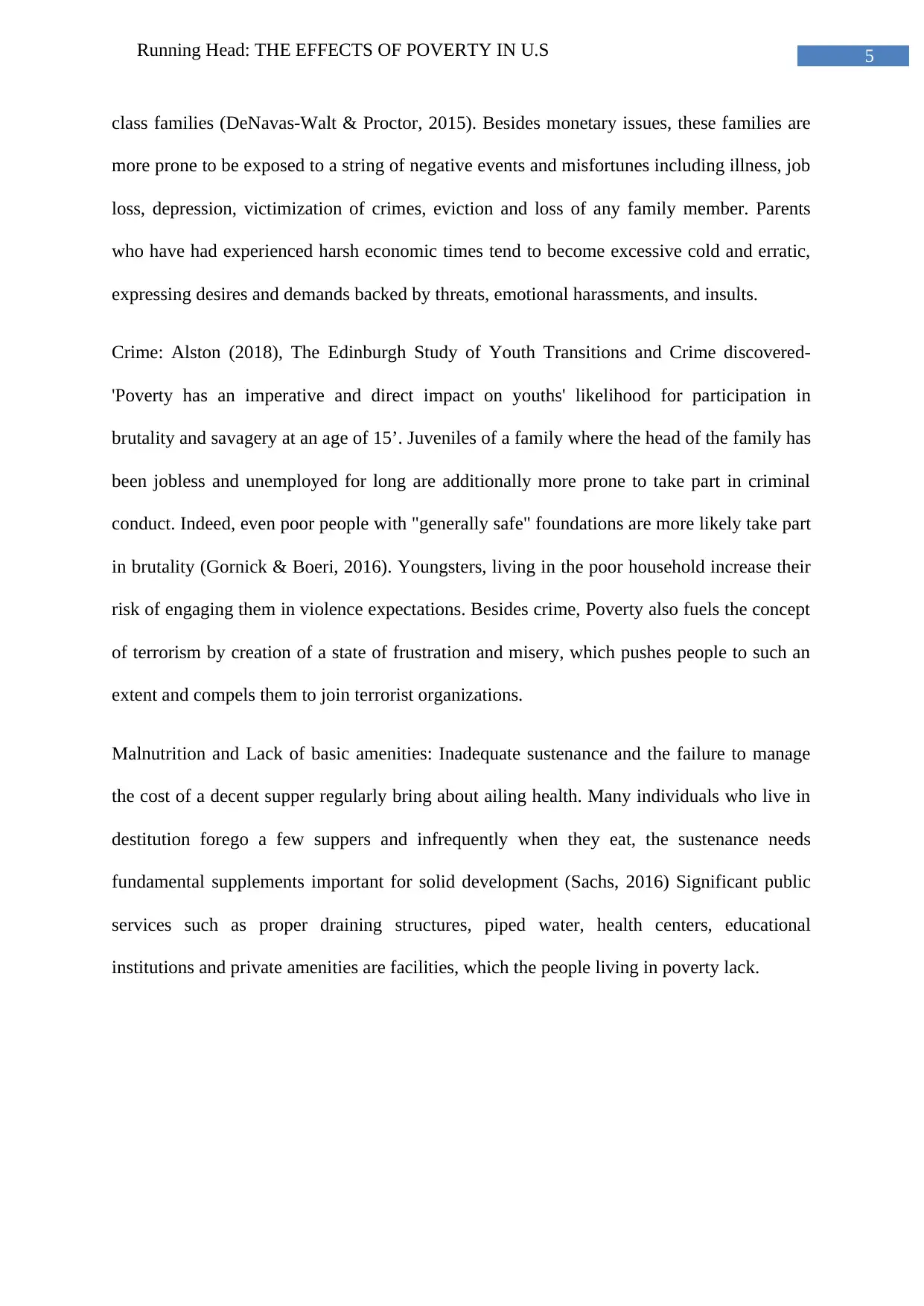
5Running Head: THE EFFECTS OF POVERTY IN U.S
class families (DeNavas-Walt & Proctor, 2015). Besides monetary issues, these families are
more prone to be exposed to a string of negative events and misfortunes including illness, job
loss, depression, victimization of crimes, eviction and loss of any family member. Parents
who have had experienced harsh economic times tend to become excessive cold and erratic,
expressing desires and demands backed by threats, emotional harassments, and insults.
Crime: Alston (2018), The Edinburgh Study of Youth Transitions and Crime discovered-
'Poverty has an imperative and direct impact on youths' likelihood for participation in
brutality and savagery at an age of 15’. Juveniles of a family where the head of the family has
been jobless and unemployed for long are additionally more prone to take part in criminal
conduct. Indeed, even poor people with "generally safe" foundations are more likely take part
in brutality (Gornick & Boeri, 2016). Youngsters, living in the poor household increase their
risk of engaging them in violence expectations. Besides crime, Poverty also fuels the concept
of terrorism by creation of a state of frustration and misery, which pushes people to such an
extent and compels them to join terrorist organizations.
Malnutrition and Lack of basic amenities: Inadequate sustenance and the failure to manage
the cost of a decent supper regularly bring about ailing health. Many individuals who live in
destitution forego a few suppers and infrequently when they eat, the sustenance needs
fundamental supplements important for solid development (Sachs, 2016) Significant public
services such as proper draining structures, piped water, health centers, educational
institutions and private amenities are facilities, which the people living in poverty lack.
class families (DeNavas-Walt & Proctor, 2015). Besides monetary issues, these families are
more prone to be exposed to a string of negative events and misfortunes including illness, job
loss, depression, victimization of crimes, eviction and loss of any family member. Parents
who have had experienced harsh economic times tend to become excessive cold and erratic,
expressing desires and demands backed by threats, emotional harassments, and insults.
Crime: Alston (2018), The Edinburgh Study of Youth Transitions and Crime discovered-
'Poverty has an imperative and direct impact on youths' likelihood for participation in
brutality and savagery at an age of 15’. Juveniles of a family where the head of the family has
been jobless and unemployed for long are additionally more prone to take part in criminal
conduct. Indeed, even poor people with "generally safe" foundations are more likely take part
in brutality (Gornick & Boeri, 2016). Youngsters, living in the poor household increase their
risk of engaging them in violence expectations. Besides crime, Poverty also fuels the concept
of terrorism by creation of a state of frustration and misery, which pushes people to such an
extent and compels them to join terrorist organizations.
Malnutrition and Lack of basic amenities: Inadequate sustenance and the failure to manage
the cost of a decent supper regularly bring about ailing health. Many individuals who live in
destitution forego a few suppers and infrequently when they eat, the sustenance needs
fundamental supplements important for solid development (Sachs, 2016) Significant public
services such as proper draining structures, piped water, health centers, educational
institutions and private amenities are facilities, which the people living in poverty lack.
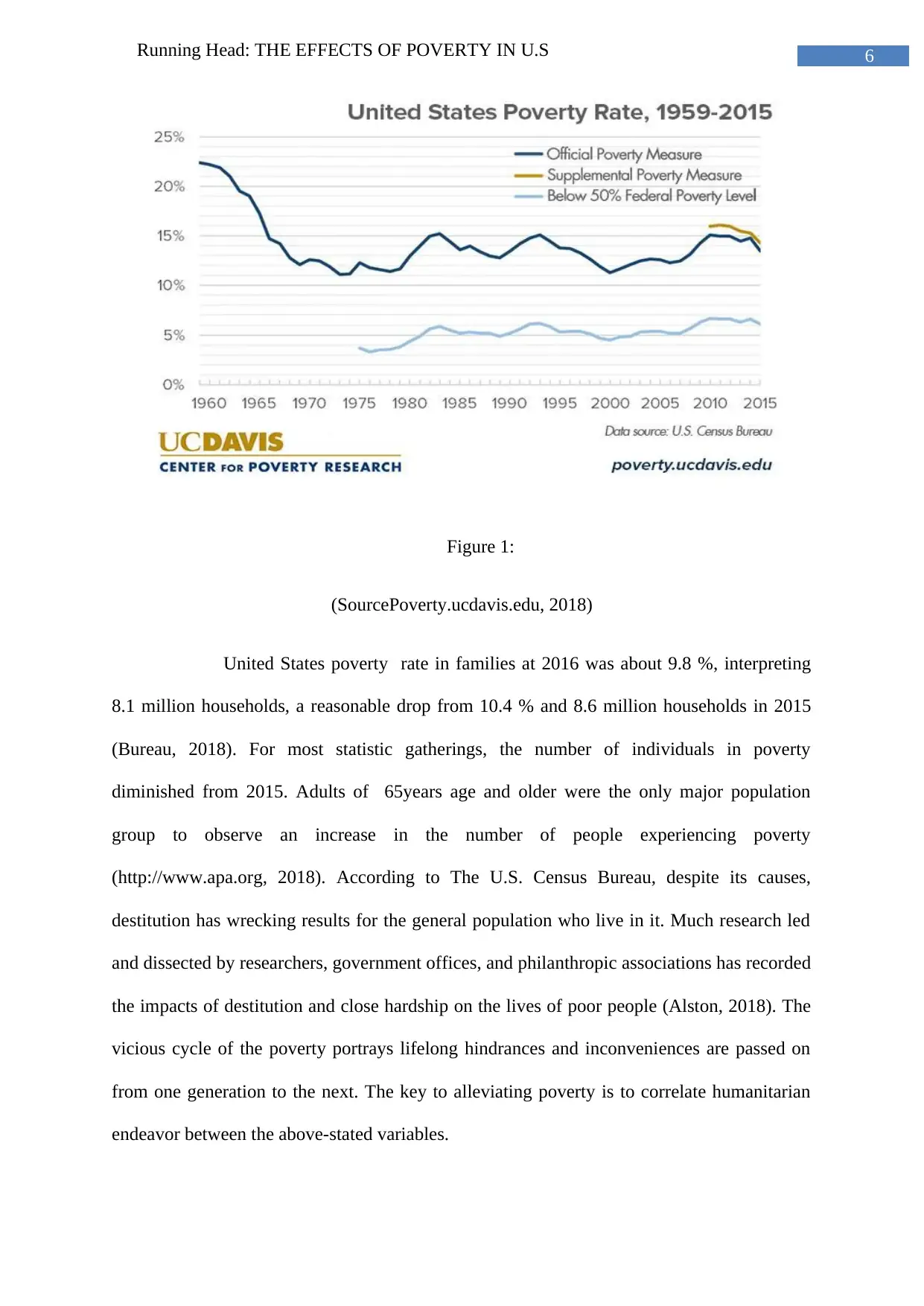
6Running Head: THE EFFECTS OF POVERTY IN U.S
Figure 1:
(SourcePoverty.ucdavis.edu, 2018)
United States poverty rate in families at 2016 was about 9.8 %, interpreting
8.1 million households, a reasonable drop from 10.4 % and 8.6 million households in 2015
(Bureau, 2018). For most statistic gatherings, the number of individuals in poverty
diminished from 2015. Adults of 65years age and older were the only major population
group to observe an increase in the number of people experiencing poverty
(http://www.apa.org, 2018). According to The U.S. Census Bureau, despite its causes,
destitution has wrecking results for the general population who live in it. Much research led
and dissected by researchers, government offices, and philanthropic associations has recorded
the impacts of destitution and close hardship on the lives of poor people (Alston, 2018). The
vicious cycle of the poverty portrays lifelong hindrances and inconveniences are passed on
from one generation to the next. The key to alleviating poverty is to correlate humanitarian
endeavor between the above-stated variables.
Figure 1:
(SourcePoverty.ucdavis.edu, 2018)
United States poverty rate in families at 2016 was about 9.8 %, interpreting
8.1 million households, a reasonable drop from 10.4 % and 8.6 million households in 2015
(Bureau, 2018). For most statistic gatherings, the number of individuals in poverty
diminished from 2015. Adults of 65years age and older were the only major population
group to observe an increase in the number of people experiencing poverty
(http://www.apa.org, 2018). According to The U.S. Census Bureau, despite its causes,
destitution has wrecking results for the general population who live in it. Much research led
and dissected by researchers, government offices, and philanthropic associations has recorded
the impacts of destitution and close hardship on the lives of poor people (Alston, 2018). The
vicious cycle of the poverty portrays lifelong hindrances and inconveniences are passed on
from one generation to the next. The key to alleviating poverty is to correlate humanitarian
endeavor between the above-stated variables.
⊘ This is a preview!⊘
Do you want full access?
Subscribe today to unlock all pages.

Trusted by 1+ million students worldwide
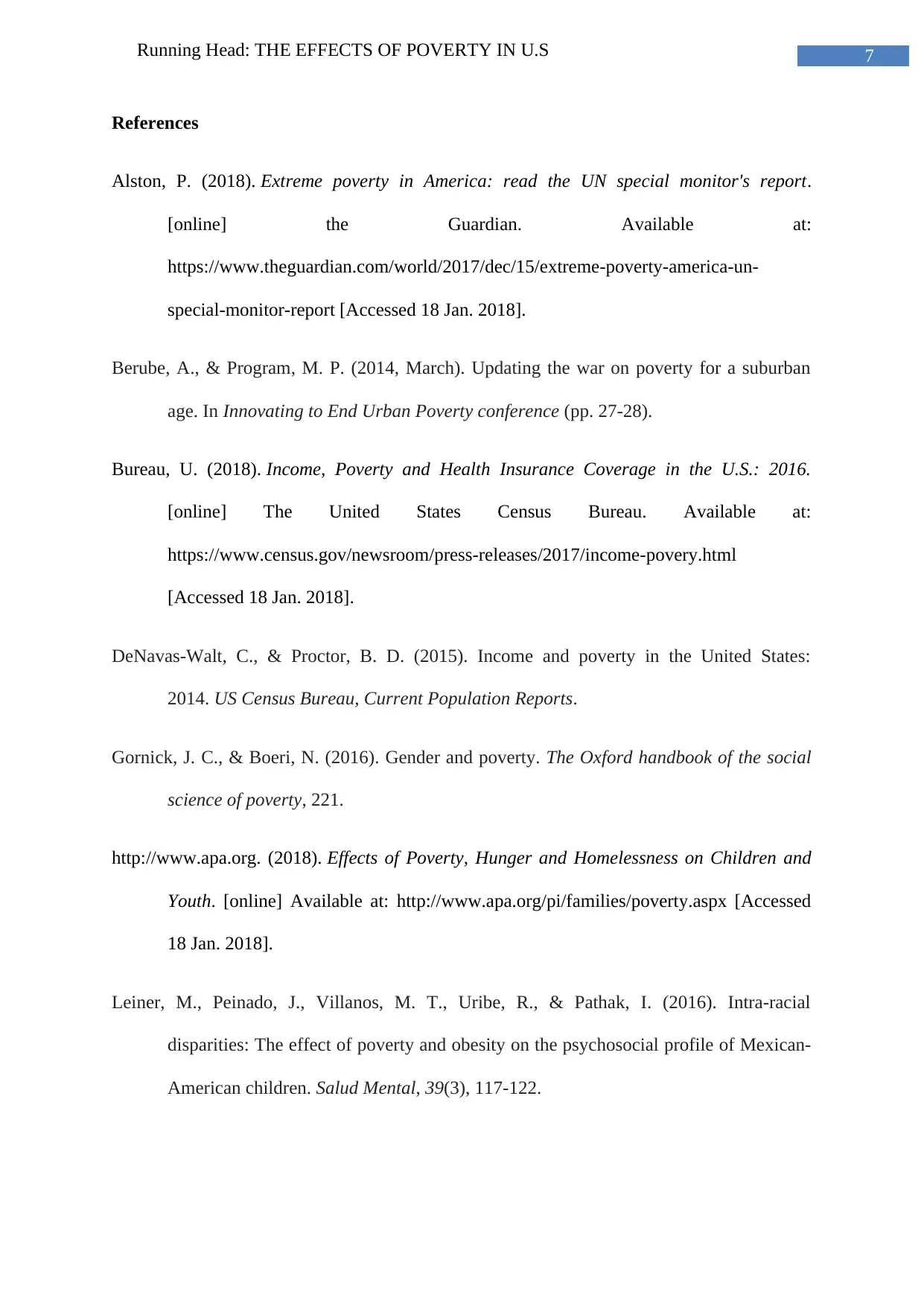
7Running Head: THE EFFECTS OF POVERTY IN U.S
References
Alston, P. (2018). Extreme poverty in America: read the UN special monitor's report.
[online] the Guardian. Available at:
https://www.theguardian.com/world/2017/dec/15/extreme-poverty-america-un-
special-monitor-report [Accessed 18 Jan. 2018].
Berube, A., & Program, M. P. (2014, March). Updating the war on poverty for a suburban
age. In Innovating to End Urban Poverty conference (pp. 27-28).
Bureau, U. (2018). Income, Poverty and Health Insurance Coverage in the U.S.: 2016.
[online] The United States Census Bureau. Available at:
https://www.census.gov/newsroom/press-releases/2017/income-povery.html
[Accessed 18 Jan. 2018].
DeNavas-Walt, C., & Proctor, B. D. (2015). Income and poverty in the United States:
2014. US Census Bureau, Current Population Reports.
Gornick, J. C., & Boeri, N. (2016). Gender and poverty. The Oxford handbook of the social
science of poverty, 221.
http://www.apa.org. (2018). Effects of Poverty, Hunger and Homelessness on Children and
Youth. [online] Available at: http://www.apa.org/pi/families/poverty.aspx [Accessed
18 Jan. 2018].
Leiner, M., Peinado, J., Villanos, M. T., Uribe, R., & Pathak, I. (2016). Intra-racial
disparities: The effect of poverty and obesity on the psychosocial profile of Mexican-
American children. Salud Mental, 39(3), 117-122.
References
Alston, P. (2018). Extreme poverty in America: read the UN special monitor's report.
[online] the Guardian. Available at:
https://www.theguardian.com/world/2017/dec/15/extreme-poverty-america-un-
special-monitor-report [Accessed 18 Jan. 2018].
Berube, A., & Program, M. P. (2014, March). Updating the war on poverty for a suburban
age. In Innovating to End Urban Poverty conference (pp. 27-28).
Bureau, U. (2018). Income, Poverty and Health Insurance Coverage in the U.S.: 2016.
[online] The United States Census Bureau. Available at:
https://www.census.gov/newsroom/press-releases/2017/income-povery.html
[Accessed 18 Jan. 2018].
DeNavas-Walt, C., & Proctor, B. D. (2015). Income and poverty in the United States:
2014. US Census Bureau, Current Population Reports.
Gornick, J. C., & Boeri, N. (2016). Gender and poverty. The Oxford handbook of the social
science of poverty, 221.
http://www.apa.org. (2018). Effects of Poverty, Hunger and Homelessness on Children and
Youth. [online] Available at: http://www.apa.org/pi/families/poverty.aspx [Accessed
18 Jan. 2018].
Leiner, M., Peinado, J., Villanos, M. T., Uribe, R., & Pathak, I. (2016). Intra-racial
disparities: The effect of poverty and obesity on the psychosocial profile of Mexican-
American children. Salud Mental, 39(3), 117-122.
Paraphrase This Document
Need a fresh take? Get an instant paraphrase of this document with our AI Paraphraser
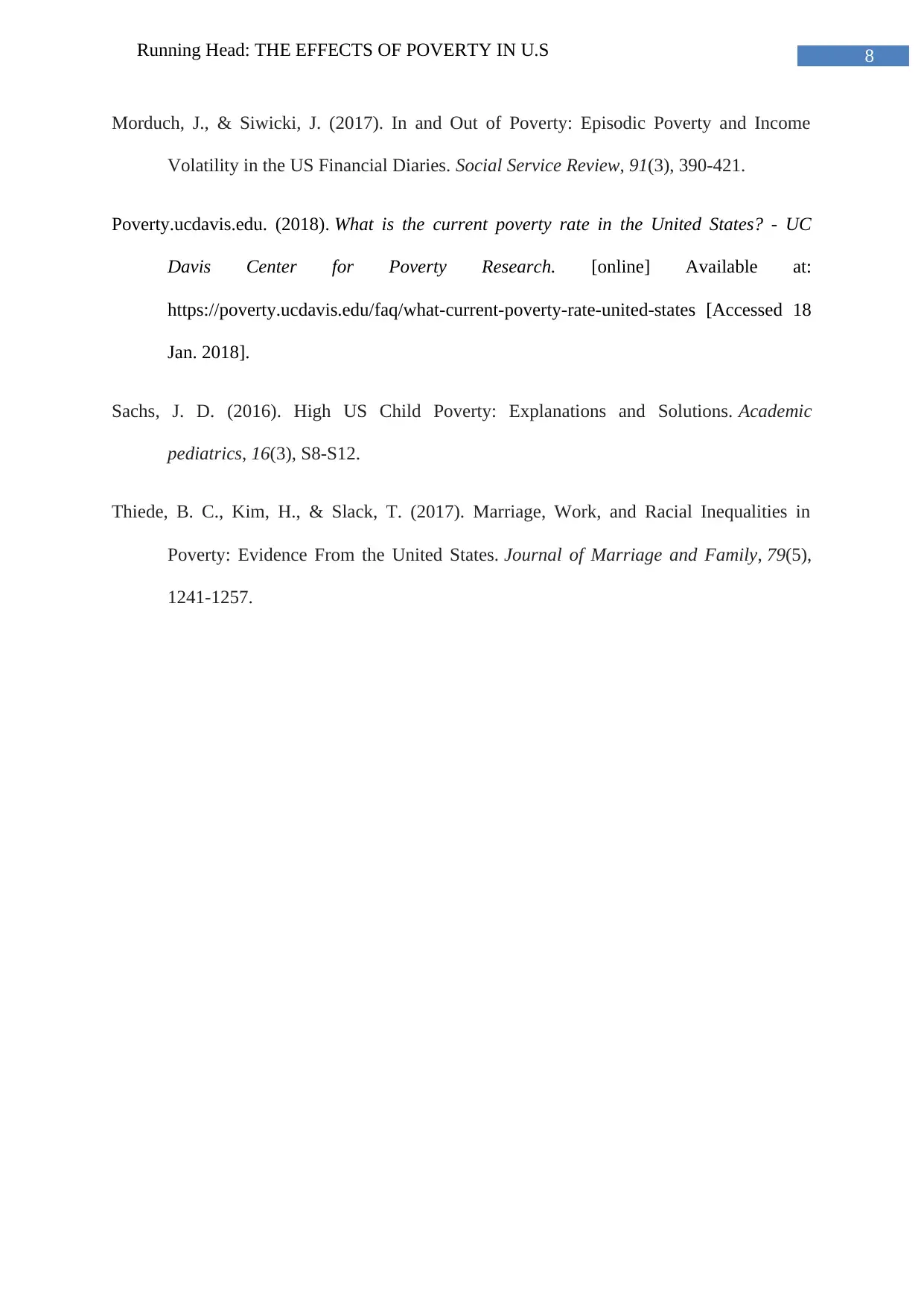
8Running Head: THE EFFECTS OF POVERTY IN U.S
Morduch, J., & Siwicki, J. (2017). In and Out of Poverty: Episodic Poverty and Income
Volatility in the US Financial Diaries. Social Service Review, 91(3), 390-421.
Poverty.ucdavis.edu. (2018). What is the current poverty rate in the United States? - UC
Davis Center for Poverty Research. [online] Available at:
https://poverty.ucdavis.edu/faq/what-current-poverty-rate-united-states [Accessed 18
Jan. 2018].
Sachs, J. D. (2016). High US Child Poverty: Explanations and Solutions. Academic
pediatrics, 16(3), S8-S12.
Thiede, B. C., Kim, H., & Slack, T. (2017). Marriage, Work, and Racial Inequalities in
Poverty: Evidence From the United States. Journal of Marriage and Family, 79(5),
1241-1257.
Morduch, J., & Siwicki, J. (2017). In and Out of Poverty: Episodic Poverty and Income
Volatility in the US Financial Diaries. Social Service Review, 91(3), 390-421.
Poverty.ucdavis.edu. (2018). What is the current poverty rate in the United States? - UC
Davis Center for Poverty Research. [online] Available at:
https://poverty.ucdavis.edu/faq/what-current-poverty-rate-united-states [Accessed 18
Jan. 2018].
Sachs, J. D. (2016). High US Child Poverty: Explanations and Solutions. Academic
pediatrics, 16(3), S8-S12.
Thiede, B. C., Kim, H., & Slack, T. (2017). Marriage, Work, and Racial Inequalities in
Poverty: Evidence From the United States. Journal of Marriage and Family, 79(5),
1241-1257.
1 out of 8
Related Documents
Your All-in-One AI-Powered Toolkit for Academic Success.
+13062052269
info@desklib.com
Available 24*7 on WhatsApp / Email
![[object Object]](/_next/static/media/star-bottom.7253800d.svg)
Unlock your academic potential
Copyright © 2020–2025 A2Z Services. All Rights Reserved. Developed and managed by ZUCOL.




